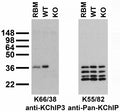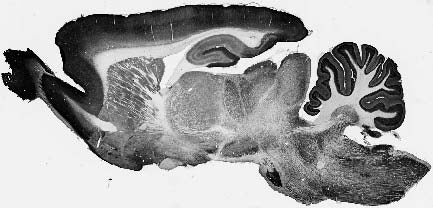Ships: 1-2 business days
Product Specific References for Applications and Species
- Immunocytochemistry: Rat
- Immunohistochemistry: Mouse | Rat
- Immunoprecipitation: Mouse
- Patch Clamp Recording: Rat
- Western Blot: Mouse | Rat
- Additional Publications: Unspecified
| Immunocytochemistry: Rat | ||
| PMID | Dilution | Publication |
| 26239200 | 1:25 | Cheng, C.F., et al. 2016. Coexpression of auxiliary subunits KChIP and DPPL in potassium channel Kv4-positive nociceptors and pain-modulating spinal interneurons.. Journal of Comparative Neurology, 846-73. |
| 22612322 | 1:500 | Pruunsild, P., et al. 2012. Subcellular localization and transcription regulatory potency of KCNIP/Calsenilin/DREAM/KChIP proteins in cultured primary cortical neurons do not provide support for their role in CRE-dependent gene expression.. Journal of Neurochemistry, 29-43. |
| 20154682 | 1:250 | Anderson, D., et al. 2010. Regulation of neuronal activity by Cav3-Kv4 channel signaling complexes.. Nature Neuroscience, 333-7. |
| Immunohistochemistry: Mouse | ||
| PMID | Dilution | Publication |
| 22612819 | not listed | Menegola, M., et al. 2012. The importance of immunohistochemical analyses in evaluating the phenotype of Kv channel knockout mice.. Epilepsia, 142-149. |
| 17122038 | not listed | Menegola, M. , et al. 2006. Unanticipated region- and cell-specific downregulation of individual KChIP auxiliary subunit isotypes in Kv4.2 knock-out mouse brain.. Journal of Neuroscience, 2137-42. |
| Immunohistochemistry: Rat | ||
| PMID | Dilution | Publication |
| 32899153 | not listed | Alfaro-Ruíz, R., et al. 2020. Cellular and subcellular localisation of kv4-associated kchip proteins in the rat cerebellum. . International journal of molecular sciences, 6403. |
| 26239200 | 1:25 | Cheng, C.F., et al. 2016. Coexpression of auxiliary subunits KChIP and DPPL in potassium channel Kv4-positive nociceptors and pain-modulating spinal interneurons.. Journal of Comparative Neurology, 846-73. |
| 25355692 | 1:25 | Wang, W.C., et al. 2015. Immunohistochemical localization of DPP10 in rat brain supports the existence of a Kv4/KChIP/DPPL ternary complex in neurons. Journal of Comparative Neurology, 523(4), pp.608-628.. Journal of Comparative Neurology, 608-628. |
| 24037673 | not listed | Rainnie, D.G., et al. 2014. Distribution and functional expression of Kv4 family α subunits and associated KChIP β subunits in the bed nucleus of the stria terminalis.. Journal of Comparative Neurology, 609-25. |
| 22820170 | 1:200 | Matsuyoshi, H., et al. 2012. Distinct cellular distributions of Kv4 pore-forming and auxiliary subunits in rat dorsal root ganglion neurons.. Life Sciences, 258-263. |
| 18727953 | not listed | Monaghan, M.M., et al. 2008. Altered expression and localization of hippocampal A-type potassium channel subunits in the pilocarpine-induced model of temporal lobe epilepsy.. Neuroscience, 550-62. |
| Immunoprecipitation: Mouse | ||
| PMID | Dilution | Publication |
| 19923600 | 1:1000 | Alexander, J.C., et al. 2009. The role of calsenilin/DREAM/KChIP3 in contextual fear conditioning.. Learning & Memory, 167-77. |
| Patch Clamp Recording: Rat | ||
| PMID | Dilution | Publication |
| 24756640 | 1:100 | Sanchez‐Aguilera, A., et al. 2014. A novel short-term plasticity of intrinsic excitability in the hippocampal CA1 pyramidal cells.. The Journal of Physiology, 2845-64. |
| Western Blot: Mouse | ||
| PMID | Dilution | Publication |
| 32822706 | not listed | Tiwari, D., et al. 2020. The potassium channel Kv4. 2 regulates dendritic spine morphology, electroencephalographic characteristics and seizure susceptibility in mice.. Experimental Neurology, 113437. |
| 32562430 | 1:1000 | Lee, S.H., et al. 2020. Haploinsufficiency of Cyfip2 Causes Lithium‐Responsive Prefrontal Dysfunction. . Annals of Neurology, 88(3), pp., 526-543. |
| 22311982 | not listed | Foeger, N.C., et al. 2012. Augmentation of Kv4.2-encoded currents by accessory dipeptidyl peptidase 6 and 10 subunits reflects selective cell surface Kv4.2 protein stabilization.. The Journal of Biological Chemistry, 9640-9650. |
| 21943606 | 1:1000 | Sun, W., et al. 2011. DPP6 establishes the A-type K(+) current gradient critical for the regulation of dendritic excitability in CA1 hippocampal neurons.. Neuron, 1102-15. |
| 20943905 | not listed | Norris, A.J., et al. 2010. Interdependent roles for accessory KChIP2, KChIP3, and KChIP4 subunits in the generation of Kv4-encoded IA channels in cortical pyramidal neurons.. Journal of Neuroscience, 13644-13655. |
| 19223600 | 1:1000 | Alexander, J.C., et al. 2009. The role of calsenilin/DREAM/KChIP3 in contextual fear conditioning.. Learning & Memory, 167-77. |
| 19223600 | 1:1000 | Alexander, J.C., et al. 2009. The role of calsenilin/DREAM/KChIP3 in contextual fear conditioning. Learning & Memory, 167-77. |
| 19223600 | 1:1000 | Alexander, J.C., et al. 2009. The role of calsenilin/DREAM/KChIP3 in contextual fear conditioning.. Learning & Memory, 167-77. |
| 18187474 | not listed | Nerbonne, J.M., et al. 2008. Electrical remodelling maintains firing properties in cortical pyramidal neurons lacking KCND2-encoded A-type K+ currents.. The Journal of Physiology, 1565-1579. |
| Western Blot: Rat | ||
| PMID | Dilution | Publication |
| 26239200 | not listed | Cheng, C.F., et al. 2016. Coexpression of auxiliary subunits KChIP and DPPL in potassium channel Kv4-positive nociceptors and pain-modulating spinal interneurons.. Journal of Comparative Neurology, 846-73. |
| 25510858 | 1:1000 | Mulholland, P.J., et al. 2015. Neuroplasticity of A-type potassium channel complexes induced by chronic alcohol exposure enhances dendritic calcium transients in hippocampus.. Psychopharmacology, 1995-2006. |
| 22612322 | 1:2000 | Pruunsild, P., et al. 2012. Subcellular localization and transcription regulatory potency of KCNIP/Calsenilin/DREAM/KChIP proteins in cultured primary cortical neurons do not provide support for their role in CRE-dependent gene expression.. Journal of Neurochemistry, 29-43. |
| 20154682 | not listed | Anderson, D., et al. 2010. Regulation of neuronal activity by Cav3-Kv4 channel signaling complexes.. Nature Neuroscience, 333-7. |
| Additional Publications: Unspecified | ||
| PMID | Publication | |
| 23637173 | Anderson, D., et al. 2013. The Cav3-Kv4 complex acts as a calcium sensor to maintain inhibitory charge transfer during extracellular calcium fluctuations.. Journal of Neuroscience, 7811-24. | |




